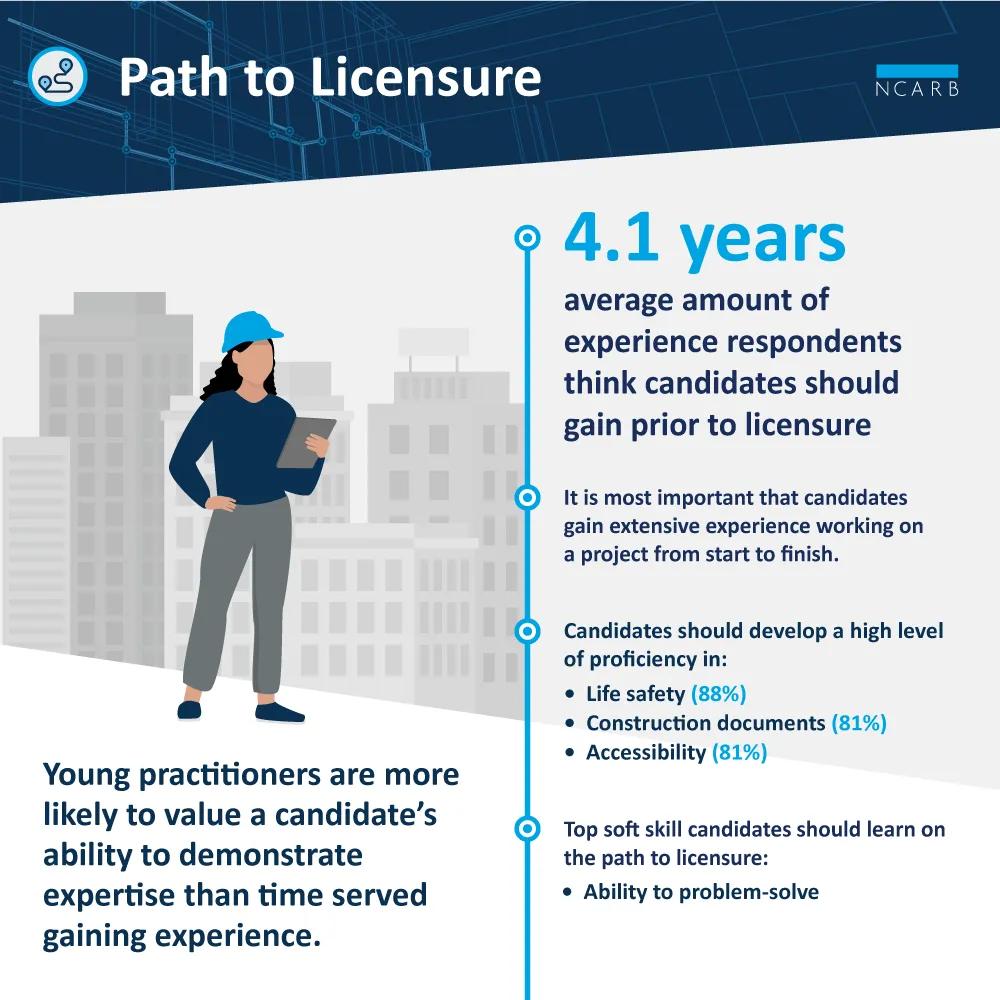As part of the Analysis of Practice Study, respondents were asked to share their perspectives on the level of knowledge, proficiencies, and experience that candidates should have gained or demonstrated by the time they are licensed.

The results revealed some interesting patterns regarding how different generations within the profession value experience and knowledge—as well as some surprisingly different perspectives on the levels candidates should attain.
“Life Safety” Is the Most Necessary Knowledge Area
Of 38 knowledge areas within practice, participants most frequently indicated that new architects needed to demonstrate a medium-to-high level of knowledge in life safety (88%). This was true within all demographic groups, with accessibility (81%), construction documents (81%), codes (80%), and constructability (80%) also consistently ranking high.
The least-selected areas where demonstrating knowledge is important were project financials (40%), fees and negotiations (39%), cost estimation (31%), geotechnical understanding (25%), and marketing (21%).
“Problem Solving” and “Professionalism” Are Top Proficiencies
| Top Five | Bottom Five |
|---|---|
| Problem Solving | Leadership |
| Professionalism | Practice Management |
| Critical Thinking | Negotiation Skills |
| Verbal Communication | Ability to Learn New Technologies |
| Written Communication | Networking |
When asked about the proficiencies that new architects need to exhibit, 80% of respondents indicated that candidates should demonstrate proficiency in problem solving and professionalism. Critical thinking was a close third, favored by 78% of respondents. Of the 27 proficiencies listed, networking, the ability to learn new technologies, and negotiation skills were ranked as the lowest proficiencies required for licensure.
Next Generation Architects Value Proficiency Over Experience
Individuals with 1-5 years of experience in architecture typically had a high expectation of the levels of knowledge and proficiency they should reach prior to licensure, while architects who have been practicing for some time tend to have lower proficiency expectations.
However, the same experienced architects tend to place more value on experience, with an average of 4.1 years of experience considered optimum. Meanwhile, those with 1-5 years of experience considered 3.6 years optimum.
Full Project Involvement Is the Most Valuable Experience
When asked to indicate the “experiences” candidates should gain as part of the licensure process, participants placed the most value on experiencing a project from start to finish (81%). Experience working in different construction types (73%) and experience working with an interdisciplinary group of professionals (70%) were also ranked highly.
All three of these relate to a variety of exposure. Conversely, specialized experience (29%) was the least selected experience area.
What’s Next?
Over the coming years, NCARB will continue evolving the licensure process, including knowledge, skills, and experiences required for licensure. We look forward to sharing more insights from other sections of the Analysis of Practice with you in the months ahead.
About the Analysis of Practice
In 2022, over 19,000 individuals across the architecture, engineering, and construction (AEC) industry participated in NCARB’s once-in-a-decade Analysis of Practice study. Through a series of short questionnaires, focus groups, a final extensive survey, and more, NCARB gathered key insights about the field of architecture that will help shape the licensing model of the future. Results from the study will help us better understand the ecosystem of architectural practice and may lead to changes to NCARB’s national licensing programs and standards of the future.